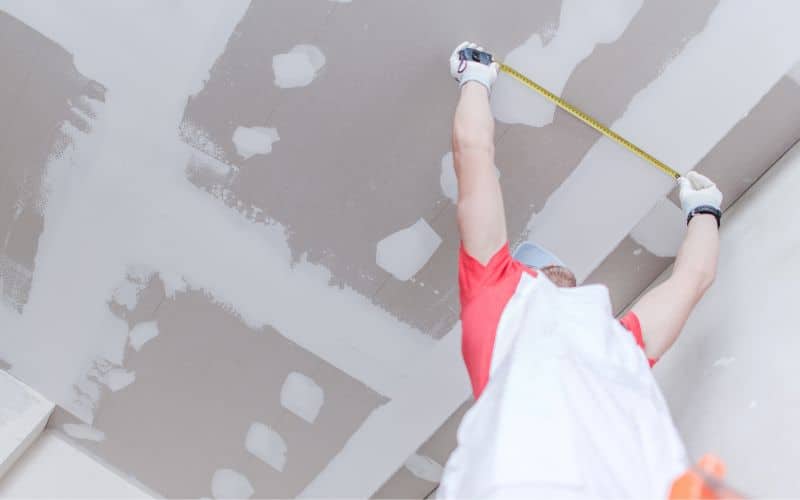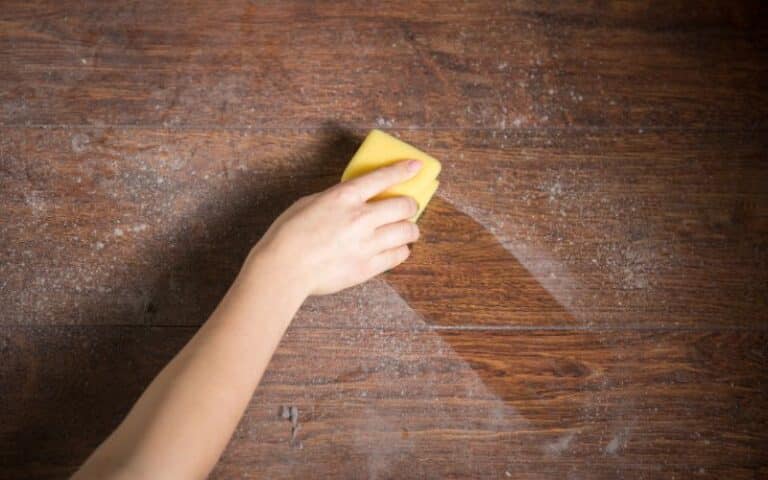When it comes to home renovations or construction projects, it’s necessary to ensure that the contractor plans and completes the job correctly.
Ensuring a good job is especially true regarding drywall installation, as a bad job can result in structural damage and health hazards.
In this article, we’ll explore ten signs that will assist you in identifying a poor drywall job, which will help you take action and correct it if possible.
Though identifying a poor drywall job can be challenging, some signs you should look for include uneven surfaces, wall holes, cracks, and a poor finish. Additionally, if the drywall is sagging or is not properly connecting to the studs, it could be a sign of a lousy drywall job.
In this article, we will identify the signs showing that your contractor performed a poor drywall installation job.
We would also address these issues to guarantee your home’s strength and structural integrity.
Ready for a Drywall Quiz?
10 Things That Identifies a Bad Drywall Job

You might need to inspect the drywall installation closely to identify signs of a poor drywall job in your construction project.
However, some signs to watch out for include visible drywall joints, very rough surfaces, indentations, or creases.
However, here are ten signs that can help you identify a bad drywall job in more detail:
#1. Uneven Joint Lines
If you or your contractor has installed the drywall poorly, it could have noticeable uneven joint lines on the drywall surface.
Uneven joint lines can be due to incorrect installation techniques, such as using a small amount of joint compound or improper joint sanding techniques.
#2. Visible Screws or Nails
When you notice screws or nails on the surface of the drywall, it is also a sign of a bad drywall job.
The nails on the wall’s surface indicate that you didn’t install the drywall properly, as they should be beneath the drywall surface.
#3. Popped Screws or Nails
When the nails or screws that hold the drywall securely become loose, it results in popped screws or nails.
Popped screws cause an indentation on the drywall surface, indicating poor installation. If you look closely enough, you will notice small circular divots to spot the defect.
#4. Cracks
A crack on your drywall, though common, may lead to further issues. They are also a sign of lousy drywall installation.
Drywall cracks can also be due to various factors, including temperature changes, poor installation, or structural adjustments.
#5. Poor Finish
Just as it implies, a poor finish indicates that you finished the drywall poorly. The poor finish can include uneven texture, visible patches, and bumps on the surface.
You may also notice bumpy areas on the drywall surface.
#6. Mold or Mildew
The drywall might develop mold if you install it in a damp environment or fail to seal it properly. Mildew or mold on your drywall can harm your health and is also a bad drywall job.
To spot moldy drywall, you will notice black or green patches on the drywall surface.
#7. Wavy Walls
If the drywall surface appears curved or wavy, it signifies a poor drywall job. The wavy surface of the drywall is due to improper installation techniques.
To spot this defect, you would notice a slight curve on the drywall or more visible bulges or waves.
#8. Poor Soundproofing
Drywalls are also necessary for creating sound barriers, but if you do not install the drywall properly, it may not block sounds effectively.
If you installed drywall with soundproofing in mind but still hear sounds from other rooms, it might be due to a bad drywall job.
#9. Uneven Corners
An uneven corner of the drywall is also an indicator of a poor drywall job.
Due to the uneven edges, you might notice some visible tape or joint compound and corners that may not meet the necessary level of straightness.
#10. Poorly Cut Edges
If you do not cut your drywall properly, it can result in uneven gaps between the drywall sheets. Ensure your contractor cuts the drywall properly to prevent jagged, uneven edges.
Can You Get a Refund for a Poor Drywall Job?
Though getting a refund might be difficult, you can get a refund with the proper procedure.
You can lodge a complaint with the contractor’s licensing board or file a lawsuit to pursue the refund if necessary.
If you are not satisfied with the quality of the drywall job done in your home, getting a refund is a good option you could explore.
However, you must review the terms and conditions of the contract with the company or the drywall contractor.
Ideally, the contract should outline the timeline of the work, the scope of the work, and the cost of the job.
The contract terms should also outline the necessary provisions for refunds or fixes for substandard work.
Getting a refund would be much easier if the contract included a satisfaction warranty with promises to fix drywall issues or allocate refunds when necessary.
In this case, you could contact the company or contractor and explain your concerns about the drywall job.
You could also provide any possible evidence to prove your claims. Moreover, the company may offer to fix the issue or refund you if they cannot fix the bad drywall job.
However, if your contract does not include a warranty that guarantees fixture of any issues with the drywall, you might still require a refund.
There are consumer protection laws that ensure contractors meet a certain standard.
If you believe the job falls short of these standards, you can file a complaint with the consumer protection agency or in court.
Ensure you document evidence of the bad drywall job, any other evidence of poor quality work, and any correspondence you had with the contractor.
However, it is worth noting that pursuing a refund or seeking legal action should be a last resort. Generally, it is better to try and work out a resolution with the contractor first.
But if you cannot reach a satisfactory agreement with the company or contractor, you can escalate the matter to a higher authority.
Can You Fix a Poor Drywall Job?
You can fix a poor drywall job, but it depends on the extent of damage and the tools and time you have available.
If you hired a contractor or did a drywall job yourself, you might notice minor defects that require fixing.
If you plan to fix the drywall job, here are some steps you can take to fix a bad drywall job:
#1. Assess the Damage
Before starting the repairs, you need to determine the extent of the damage to the drywall. Assess the drywall surface for cracks, holes, and rough, uneven surfaces.
If the damage is minor, you might be able to repair it with some simple fixes. However, if the damage is more severe, you might need to replace the drywall.
#2. Prepare the Area
After assessing the drywall, you need to prepare the drywall area.
Preparing the area involves removing any loose or faulty drywall, cleaning the area, and ensuring the surface is debris-free.
#3. Make Repairs
Depending on the damage to the drywall, you may need to fill an empty hole, smoothen bumps, or patch cracks.
You can use a joint compound, a putty knife, and drywall tape to make the repairs. However, you can also purchase a hole repair kit for about $10 to $30.
Follow the manufacturer’s instructions and allow the joint compound to dry completely.
#4. Sand and Smooth
Once the compound has dried, sand and smoothen the surface. For this, you will need a sanding block or a power sander.
Also, wear a mask to shield your face and eyes from dust.
#5. Prime and Paint
Finally, prime and paint the surface. However, ensure the surface is clean and dry before painting and priming.
It’s worth noting that fixing a bad drywall job can be labor-intensive and time-consuming.
However, if you are unsure you can fix the drywall, you should hire a professional to repair it.
Here is a table showing common problems you can fix in a poor drywall job:
| Problem | Possible Solutions |
|---|---|
| Uneven surface | Sanding, skim coating, or applying joint compound |
| Visible screws or nails | Re-sinking or removing and replacing screws/nails |
| Poor taping and mudding | Removing old tape and mud, re-taping, and mudding |
| Poor texture or finish | Sanding, adding texture, or reapplying paint |
| Gaps between drywall sheets | Filling gaps with joint compound or drywall tape |
How Much Does It Cost To Fix a Bad Drywall Job?
Generally, the average cost for repairing bad drywall jobs is $50 to $80 per square foot.
However, the cost can vary greatly depending on how bad the job is, the work you must fix, and how it affects the surrounding drywall.
Moreover, minor issues such as small holes or cracks can be fixed for a few hundred dollars.
While more extended issues, such as an uneven surface or poor taping, may cost about $1000.
It is necessary to obtain more details on the price quote from a professional contractor to properly assess the cost of fixing the bad drywall.
Here are some factors that can affect the cost:
#1. Type and Extent of Damage
The type and extent of the damage on the drywall are essential factors in determining the cost you require. Minor damages like cracks or uneven surfaces can cost $50 to $100.
However, if the damage on the drywall is quite bad, such as water damage or large cracks, the cost can be significantly higher.
#2. Labor Costs
If you hire a contractor or handyman, the cost of fixing might be higher, as you will be paying the contractor an hourly rate. On average, you will be paying between $50 to $100 per hour.
#3. Materials
The cost of the materials you will require depends on the type of drywall, paint, and tape. The cost can range from $50 to $250, depending on the extent of the damage.
#4. Accessibility
Accessibility is also important when determining the cost of the repair. If the area you need to fix is difficult to reach or is in a tricky location, it could increase the repair cost.
The price increase is because the contractor must spend more time accessing the area and may require special tools to complete the repair.
How Long Does a Good Drywall Job Last?
A good drywall job lasts for about 30 to 70 years, depending on the quality of the drywall and the conditions surrounding the installation.
If the contractor properly installs the drywall and you properly maintain it, it can last over 50 years.
However, certain factors like mold growth, moisture, and regular wear and tear can reduce the lifespan of a good drywall job.
When the drywall comes in contact with water or moisture, it weakens and peels or breaks down.
Moisture damage is one of the common reasons why drywalls do not last long, often due to leaks, floods, or high humidity in the area.
It’s necessary to assess the area for water issues and address it immediately to prevent this damage. Also, ensure the area is well-ventilated.
Wear and tear can also affect the drywall, reducing its lifespan. This damage includes furniture scratches.
To prevent damage, carefully move the furniture and keep heavy sharp objects away from the drywall surface.
However, mold growth is also a common issue affecting drywall longevity. Moisture brings about mold; therefore, moisture in drywall can cause mold growth on the drywall surface.
Mold can also result in health complications, so it is important that you keep your drywall dry and ventilated to prevent mildew or mold growth.






